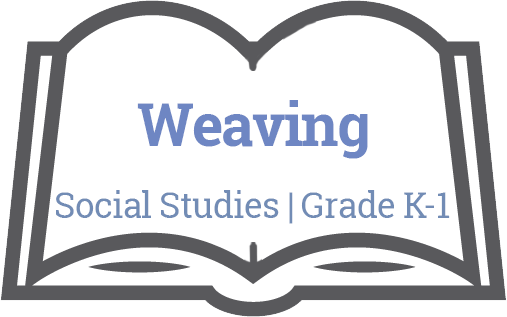
Unit Plan: Weaving
Social Studies / Grade K-1

Big Ideas
People connect to others and share ideas through the arts.
Concepts:
- Connection
- Function
Essential Questions
Students will keep considering…
- What patterns are used in weaving?
- How do you weave?
Evaluative Criteria
Teachers should consider how summative assessments should be based on clear criteria and include a variety of ways for students to show demonstrate their learning.
- Student can expertly show a weaving pattern
- Student is able to clearly describe how woven textiles are made.
Monitoring Progress
Teacher will monitor progress:
Teachers can monitor progress through ongoing formative assessment including but not limited to:
- Students share reflections on their learning throughout this process that teachers could assess
- Teachers could assess the student’s woven product
Resources
WEBSITES
- Buggy and Buddy – DIY Weaving Loom
- Arts & Creativity in Early Childhood Education – Weaving with Young Children
OTHER
- “My Metis Sash” by Leah Marie
Reflection
How will teachers and their students reflect on and evaluate the completed project?
Teacher Reflection
- What aspects of the unit went well
- What did students struggle with
- What did you struggle with?
- What would you add/revise the next time you taught this unit?
- Were there any unintended outcomes?
- Were students engaged?
Downloads
Stage 1 – Desired Results
Big Ideas
People connect to others and share ideas through the arts.
Concepts:
- Connection
- Function
Transfer Goals
Students will be able to independently use their learning to…
- Describe patterns in weaving (eg. Over-under, colour patterns, etc.).
- Construct a simple woven piece together with the class or independently
- Experiment with creating colour patterns.
Meaning
Students will understand that…
- Textiles have patterns.
- Textiles can be made by hand.
Students will keep considering…
- What patterns are used in weaving?
- How do you weave?
Acquisition
Students will be skilled at…
- Make a product using known procedures or through modeling of others.
- Demonstrate their product, tell the story of designing and making their product, and explain how their product contributes to the individual, family, community, and/or environment (Applied Design & Tech K/1).
- Incorporate First Peoples worldviews and perspectives to make connections to mathematical concepts (Math K/1).
- Create artistic works collaboratively and as an individual, using ideas inspired by imagination, inquiry, experimentation, and purposeful play(Art K/1).
CONTENT
Students will know…
- Repeating patterns with multiple elements and attributes (Math K/1)
- Visual arts: elements of design: line, shape, texture, colour, form; principles of design: pattern, repetition, rhythm, contrast (Art K/1)
Which Core Competencies will be integrated into the unit?
Critical and Creative Thinking
- Novelty and value
Personal and Social
- Personal strength and abilities.
First People's Principles of Learning
The unit will make connections with:
Learning Involves Patience and Time.
Learning Recognizes the Role of Indigenous Knowledge.

The following resources are made available through the British Columbia Ministry of Education. For more information, please visit BC’s New Curriculum.
Big Ideas
The Big Ideas consist of generalizations and principles and the key concepts important in an area of learning. The Big Ideas represent what students will understand at the completion of the curriculum for their grade. They are intended to endure beyond a single grade and contribute to future understanding.
Core Competencies
 Communications Competency
Communications Competency
The set of abilities that students use to impart and exchange information, experiences and ideas, to explore the world around them, and to understand and effectively engage in the use of digital media
 Thinking Competency
Thinking Competency
The knowledge, skills and processes we associate with intellectual development
 Social Competency
Social Competency
The set of abilities that relate to students’ identity in the world, both as individuals and as members of their community and society
Curricular Competencies & Content
Curricular Competencies are the skills, strategies, and processes that students develop over time. They reflect the “Do” in the Know-Do-Understand model of curriculum. The Curricular Competencies are built on the thinking, communicating, and personal and social competencies relevant to disciplines that make up an area of learning.
Additional Resources
First People's Principles of Learning
To read more about First People’s Principles of Learning, please click here.
For classroom resources, please visit the First Nations Education Steering Committee.
